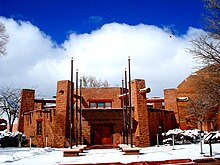National Historic Landmark






A National Historic Landmark (NHL) is a building, site, structure, object, or district with historical importance. The United States government marks them as NHLs only if they have high historical significance. Out of more than 80,000 places on the National Register of Historic Places only about 2,430 are NHLs.
A National Historic Landmark District (NHLD) is a historic district that is recognized as an NHL. It may include contributing properties that have buildings, structures, sites or objects, and it may include non-contributing properties.
History[change | change source]
On October 9, 1960, Secretary of the Interior Fred Andrew Seaton announced 92 properties as NHLs. The first of these was a political nomination, Sergeant Floyd Grave and Monument in Sioux City, Iowa as officially designated on June 30 of that year, but for various reasons the public announcement of the first several NHLs was delayed.
Criteria[change | change source]
NHLs are designated by the United States Secretary of the Interior because they are:
- Sites where events of national historical significance occurred;
- Places where prominent persons lived or worked;
- Icons (symbols) of ideals that shaped the nation;
- Outstanding examples of design or construction;
- Places characterizing a way of life; or
- Archeological sites able to yield information.
Overview of current NHLs[change | change source]
Of the 2,442 or so current NHLs, 3 states, Pennsylvania, Massachusetts, and New York account for nearly 25 percent of the nation's NHLs. In addition to these states, cities within these states, Boston, Philadelphia, and New York City (each separately) alone have more NHLs than 40 out of the 50 states. There are NHLs in all 50 states. There are 74 in the District of Columbia, 15 in Puerto Rico and other U.S. commonwealths and territories, five in U.S.-associated states such as Micronesia, and one in Morocco.[1][2]
There are 128 ships or shipwrecks that are NHLs.
Other[change | change source]
About half of the National Historic Landmarks are privately owned.[3] The National Historic Landmarks Program relies on suggestions for new designations from the National Park Service, which also assists in maintaining the landmarks. The National Historic Landmark Stewards Association is a friends' group of owners and managers who works to preserve, protect and promote National Historic Landmarks.
If not already listed on the National Register of Historic Places, an NHL is automatically added to the Register upon designation. About three percent of Register listings are NHLs.[4]
References[change | change source]
- ↑ National Park Service (November 2007). "National Historic Landmarks Survey: List of National Historic Landmarks by State" (PDF). Archived from the original (PDF) on 2007-06-09. Retrieved 2008-07-01.
- ↑ The counts and locations of NHLs are described most accurately in List of National Historic Landmarks by state. This extends, and corrects errors from, the National Park Service's "National Historic Landmarks Survey List of National Historic Landmarks by State", also referenced.
- ↑ National Historic Landmarks Update Archived 2008-09-10 at the Wayback Machine, National Park Service, October 2004
- ↑ "Title 36 of the Code of Federal Regulations, Part 65". US Government Printing Office. Archived from the original on 2012-02-17. Retrieved 2008-04-05.
